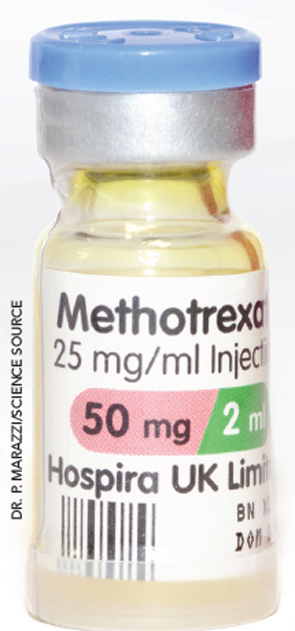
BOSTON—Methotrexate is still the cornerstone of therapy for treating rheumatoid arthritis, whether in combination with other drugs or as a monotherapy. At the ACR/ARHP Annual Meeting in Boston in November 2014, two leading experts in methotrexate research shared their insights about successfully managing RA patients with this affordable, accessible medication.
“This is a fairly simple molecule that has not only changed the field of treating a number of malignancies, but has also changed the field of treating chronic rheumatic diseases, particularly RA,” said Michael E. Weinblatt, MD, the Riedman Professor of Medicine at Harvard Medical School and co-director of clinical rheumatology at Brigham and Women’s Hospital in Boston.
Dr. Weinblatt and Joel M. Kremer, MD, professor of medicine at Albany Medical College in Albany, N.Y., discussed Clinical Issues Associated with the Use of Methotrexate on Nov. 18. Methotrexate remains the standard of care in RA management and is the best-studied disease-modifying antirheumatic drug (DMARD) to date, with more trials and long-term clinical experience than any other RA therapy. There is resurgent interest in methotrexate due to its use in combination with biologic drugs, said Dr. Weinblatt. They shared their views on using methotrexate in RA patients to improve functional status and radiographic progression of RA, lower disease activity scores and prevent adverse events.
Combination Anchor
Methotrexate may help RA patients get off glucocorticoids and nonsteroidal antiinflammatory drugs (NSAIDs), and may positively impact mortality, a major concern in RA, by “having a fairly strong impact on inflammation,” said Dr. Weinblatt. It’s even more effective as an anchor drug in combination therapy. “Methotrexate in combination, whether with oral synthetic drugs or with biologics, has generally demonstrated superiority to monotherapy.”
Used in combination, methotrexate may increase the efficacy of biologics, especially TNF inhibitors and rituximab. It may increase the serum levels of selective biologics, such as adalimumab. In one study, a dose of methotrexate below 7.5 mg per week was not as effective as higher doses when combined with adalimumab, suggesting a dose threshold with combination therapy, Dr. Weinblatt said.
Methotrexate toxicity is a common concern in RA, but the duration of exposure to the drug is the determining factor, said Dr. Kremer. Prolonged exposure to a serum level of methotrexate above 0.05 µM for more than 24 hours will result in a cytotoxic effect of rapidly dividing cells. Renal compromise may extend the half-life of methotrexate polyglutamates, he said.
“Methotrexate polyglutamates can tell us something and make us a little bit smarter in how we handle this drug clinically,” said Dr. Kremer. These metabolites both increase and decrease slowly in cells, reaching a steady state of concentration at about 28 weeks after initiation in most RA patients. Intracellular elimination half-life of methotrexate polyglutamates takes a little over four weeks. “If your patient misses his dose and says to you, ‘Doc, I feel great! The methotrexate must not be working,’ it is actually just slowly decreasing within cells, and not yet at the threshold of a diminished therapeutic effect.”
Oral absorption of methotrexate is highly variable and may drop off as much as 30% when increasing the dose from 7.5 mg to 15 mg due to bioavailability. “Switching to parenteral methotrexate can be highly effective, because the bioavailability changes,” said Dr. Kremer. “The patient’s intracellular levels of methotrexate polyglutamates are simply greater because they are seeing more drug.”
Methotrexate polyglutamates determine dosing rates, said Dr. Weinblatt. The optimal dose for most patients is between 18 mg and 25 mg per week. “It is important to get your methotrexate dose up when you treat patients with RA. Using too low a dose and then adding another therapy because a patient is just a ‘methotrexate nonresponder’ is not justified by the data,” he said.
RA patients whose disease is well controlled typically flare between four and six weeks after they discontinue methotrexate, so it’s preferable to either lower the dose or stretch out the duration between doses to every two weeks in these patients rather than completely stopping therapy, he said.
Tolerability Issues
Most RA patients who stop using methotrexate do so due to tolerability issues, such as nausea, stomatitis, diarrhea, vomiting and weight loss. Folic acid supplementation at 1 mg to 5 mg per day or folinic acid at 5 mg to 20 mg per week may reduce these events. Patients could take leucovorin (folinic acid), which is biologically active, if folic acid is not successful. Leucovorin should not be taken within eight hours of the methotrexate dose since it may block the efficacy of methotrexate if taken in this time frame. If leucovorin is dosed 48 hours after methotrexate, it may not reduce toxicities. Dr. Weinblatt said. Switching to subcutaneous methotrexate or using antiemetics may help relieve nausea, as well.
Fatigue is another common complaint, said Dr. Weinblatt. “Many patients simply do not feel well. We call this the ‘postmethotrexate blah.’” Increasing caffeine intake the day before or after treatment may blunt this effect. Painful skin nodules on the soles of the feet, palms or even the lungs may affect some patients. Local steroid injections may help treat nodules, or rheumatologists may switch to synthetic DMARDs or biologics in these patients.
Methotrexate can heighten the effects of sunburn to produce significant erythroderma, something Dr. Weinblatt described as “cooked lobster syndrome.” He advises his patients taking methotrexate to use caution in the sun and to avoid tanning salons.
Methotrexate hematologic toxicity is avoidable. The drug is cleared by the kidneys, so patients with renal insufficiency, folate deficiencies or infections; those taking daily sulfamethoxazole; or those who have made dosing errors may be at risk. “Dialysis is an absolute contraindication!” Dr. Weinblatt said. One dose of methotrexate for a patient on dialysis may be associated with bone marrow toxicity and death.
The drug is an abortifacient and teratogenic, Dr. Weinblatt said. Female RA patients who wish to conceive should stop using methotrexate for at least one to two menstrual cycles before attempting conceiving. The package insert suggests that males should wait a minimum of three months after stopping therapy before attempting conception, but there are few data to support this claim.
As for potential hepatotoxicity, RA patients taking methotrexate may vary widely in their alcohol tolerance, said Dr. Kremer. He advises patients to limit their alcohol to one drink per day. Liver function tests every four to eight weeks may help ensure that the liver is healthy in patients without elevated AST levels. “Don’t allow your patient’s transaminase levels to remain elevated. Adjust the methotrexate dose to get the AST level to normal and the liver will be happy.” Risk factors for elevated transaminases include obesity, untreated high cholesterol, pretherapy LFT elevations, use of some biologic agents and lack of folic acid supplementation.
In RA patients who also have diabetes mellitus, higher insulin levels correlate with higher lung toxicity levels, he said. Stop methotrexate in cases of patients with pulmonary infiltrates, but lower the dose and observe patients with a new, nonproductive cough. Productive, persistent coughs may be a bigger concern, and if the patient does not respond to the lower dose, stop methotrexate, he said.
Although some RA patients simply cannot tolerate the treatment, “methotrexate is likely to remain the initial drug of choice for RA for years to come,” said Dr. Kremer. “It is cost effective and inexpensive.”
Susan Bernstein is a freelance medical journalist based in Atlanta.
Second Chance
If you missed this session, it’s not too late. Catch it on SessionSelect.
